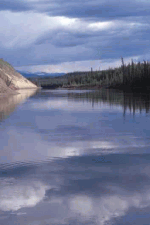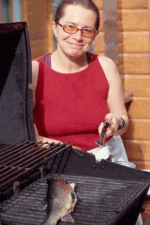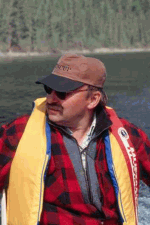Nov 2001, Vol. 6 No. 2
 The nuggets are long gone, yet gold remains in the Yukon: in its landscapes of towering glacier-covered mountains and broad valleys, in attractions that embrace the history of the Klondike Gold Rush, and in the region’s hardy people.
The nuggets are long gone, yet gold remains in the Yukon: in its landscapes of towering glacier-covered mountains and broad valleys, in attractions that embrace the history of the Klondike Gold Rush, and in the region’s hardy people.
More than a century has past since the discovery of gold near Dawson City, Yukon Territory. While the Klondike Gold Rush may have been profitable for the discoverers; most of the prospectors who followed a year later, when the news finally reached San Francisco and Portland, lost almost everything- some lost their lives. The dangers deterred few, however.
 The trip was arduous beginning with the long 10-day steamship ride from San Francisco to Skagway, Alaska. From there, the gold hunters, required to carry a ton of supplies, were faced with climbing 40 miles up the Chilkoot Pass’s “Golden Stairs” (a 45-degree ascent) or facing the slightly less daunting White Pass. While they were waiting for ice to melt on riverways, they wintered in the 40-F frigid weather near Bennett Lake, chopping wood to build the rafts required to float 600 miles down the sometimes-torrential Yukon River to their destination of Bonanza Creek.
The trip was arduous beginning with the long 10-day steamship ride from San Francisco to Skagway, Alaska. From there, the gold hunters, required to carry a ton of supplies, were faced with climbing 40 miles up the Chilkoot Pass’s “Golden Stairs” (a 45-degree ascent) or facing the slightly less daunting White Pass. While they were waiting for ice to melt on riverways, they wintered in the 40-F frigid weather near Bennett Lake, chopping wood to build the rafts required to float 600 miles down the sometimes-torrential Yukon River to their destination of Bonanza Creek.
 While the majority of visitors RV the Alaskan Highway passing through the Yukon Territory, even a week of traveling by car and floatplane barely scratches the surface of this magnificent “big sky” country. The little I saw of its toothy mountain peaks and vast valleys, whetted my appetite for further exploration. In this land of the “midnight sun”, I managed to visit some incredible places and meet some wonderful characters.
While the majority of visitors RV the Alaskan Highway passing through the Yukon Territory, even a week of traveling by car and floatplane barely scratches the surface of this magnificent “big sky” country. The little I saw of its toothy mountain peaks and vast valleys, whetted my appetite for further exploration. In this land of the “midnight sun”, I managed to visit some incredible places and meet some wonderful characters.
 Reliving the trek of the past century, well-conditioned hikers can follow the gold rush trails by hiking the challenging Chilkoot Pass traversing the trail in three to four days. Less challenging for visitors is the opportunity to relive history on a rail journey over White Pass chugging along on the White Pass & Yukon Route summit. During summer months, the restored Gold Rush-era train, with full narration of the route and history train, operates daily between Skagway and Fraser.
Reliving the trek of the past century, well-conditioned hikers can follow the gold rush trails by hiking the challenging Chilkoot Pass traversing the trail in three to four days. Less challenging for visitors is the opportunity to relive history on a rail journey over White Pass chugging along on the White Pass & Yukon Route summit. During summer months, the restored Gold Rush-era train, with full narration of the route and history train, operates daily between Skagway and Fraser.
Kluane National Park, a UNESCO World Heritage site and one of the Yukon’s great treasures is the largest national park with trail-only access. Abutting Tatshenshini-Alsek and Glacier Bay and the Wrangell-Saint Elias National Park in Alaska, thousands of RVers heading up the Alaskan Highway skirt the edges of Kluane missing its highlights.
 Without the time to hike through rock glaciers or raft the Dusty River of remote Kluane, heli-seeing is the way to go. Pilot Doug Makkonen hovers his Bell Ranger III over a plateau as Dall sheep and wild goat scurry to cliffs looking for shelter from the noise of the rotors. Skimming the edge like an amusement park ride, we flew slowly over the four-mile-wide Lowell Glacier icefields. Along our flight path, we notice unique “dust devils” created by the wind blowing silt from the river’s muddy banks, which is how the Dusty River got its name. Flying later in the day, closer to the time of the Midnight Sun, we would have seen dozens of grizzlies scavenging roots in one valley, while black bears, afraid of becoming dinner for the fiercer grizzlies, keep their distance on a nearby range.
Without the time to hike through rock glaciers or raft the Dusty River of remote Kluane, heli-seeing is the way to go. Pilot Doug Makkonen hovers his Bell Ranger III over a plateau as Dall sheep and wild goat scurry to cliffs looking for shelter from the noise of the rotors. Skimming the edge like an amusement park ride, we flew slowly over the four-mile-wide Lowell Glacier icefields. Along our flight path, we notice unique “dust devils” created by the wind blowing silt from the river’s muddy banks, which is how the Dusty River got its name. Flying later in the day, closer to the time of the Midnight Sun, we would have seen dozens of grizzlies scavenging roots in one valley, while black bears, afraid of becoming dinner for the fiercer grizzlies, keep their distance on a nearby range.
 Doug Makkonen has been flying helicopters in the Yukon for 30 years, in that time amassing 16,000 hours in the air-and a lifetime of stories. He has rescued hikers from the 20,000′ Mt. Logan. He’s roped and retrieved snowmobiles submerged in ice-swollen rivers. Life can be severe in the Yukon, fortunately there are heroes like Doug.
Doug Makkonen has been flying helicopters in the Yukon for 30 years, in that time amassing 16,000 hours in the air-and a lifetime of stories. He has rescued hikers from the 20,000′ Mt. Logan. He’s roped and retrieved snowmobiles submerged in ice-swollen rivers. Life can be severe in the Yukon, fortunately there are heroes like Doug.
Not far from Kluane, but a 100-miles from the nearest city (Haynes Junction, population: 500 friendly residents), is Tincup Lake, its 10-mile-long banks surrounded by forests of spruce and feathery birch of the Ruby range. The lake drops sharply to approximately 400 feet. In mid-June the ice thaws and lake trout, arctic grayling, and a few northern pike rise to eat the first insect hatch.
 Here we met another hardy soul with a fascinating history, another storyteller like pilot Doug Makkonen. Ron Chambers, who guides anglers for Tincup Lodge, a luxurious fly-in wilderness lodge, is a member of the Champagne Aishikik band of southern Tutchone. His ancestors played an interesting role in Gold Rush history. His great grandfather was chief of the steep-pass Chilkoot area of the Tlingit tribe, while his non-native grandfather served in the North West Mounted Police inspecting gold rushers insuring they carried a ton of supplies. Into her late seventies, his mother Grace operated a local trap line, selling the fur of wolverines, lynx, and squirrels. On June 21, the summer solstice, the sun never sets, and anglers can fish in the golden midnight light.
Here we met another hardy soul with a fascinating history, another storyteller like pilot Doug Makkonen. Ron Chambers, who guides anglers for Tincup Lodge, a luxurious fly-in wilderness lodge, is a member of the Champagne Aishikik band of southern Tutchone. His ancestors played an interesting role in Gold Rush history. His great grandfather was chief of the steep-pass Chilkoot area of the Tlingit tribe, while his non-native grandfather served in the North West Mounted Police inspecting gold rushers insuring they carried a ton of supplies. Into her late seventies, his mother Grace operated a local trap line, selling the fur of wolverines, lynx, and squirrels. On June 21, the summer solstice, the sun never sets, and anglers can fish in the golden midnight light.
 A trip to the Yukon Territory would not be complete without a dog-sledding adventure. While a summer experience, being pulled by 14-dogs in a motorless ATV, may not compare to winter sled mushing in snow, meeting the huskies, looking skinnier having shed their winter coats, is a kick. Summer rains have come and the trail is muddy, so LeBlanc brakes to keep the pace slow in the mud, as he commands the Dogs, with Spook and Brownie leading the way, to “haw” or “gee” (turn left or right).
A trip to the Yukon Territory would not be complete without a dog-sledding adventure. While a summer experience, being pulled by 14-dogs in a motorless ATV, may not compare to winter sled mushing in snow, meeting the huskies, looking skinnier having shed their winter coats, is a kick. Summer rains have come and the trail is muddy, so LeBlanc brakes to keep the pace slow in the mud, as he commands the Dogs, with Spook and Brownie leading the way, to “haw” or “gee” (turn left or right).
Like athletes, when he selects his team, the dogs run with eagerness to be harnessed, yelping with excitement. The dogs follow every command; their trust in Le Blanc is apparent. At the end of the ride, each dog is given water flavored with dog food; because they are unused to drinking during races, they must be coaxed to drink with this treat.
 Sebastian LeBlanc is a master guide, and his love for his 90 dogs is evident. “I look for dogs who look like spiders; no bodies, just long legs.” He not only knows the name and favorite kennel of each dog, he recognizes their individual barks. The dogs are fed fish, chicken, moose, and, sometimes a special treat, horsemeat. LeBlanc trains the dogs year round , taking them on 40-mile runs. They’re all tri-lingual, responding to commands in German, French, and English.
Sebastian LeBlanc is a master guide, and his love for his 90 dogs is evident. “I look for dogs who look like spiders; no bodies, just long legs.” He not only knows the name and favorite kennel of each dog, he recognizes their individual barks. The dogs are fed fish, chicken, moose, and, sometimes a special treat, horsemeat. LeBlanc trains the dogs year round , taking them on 40-mile runs. They’re all tri-lingual, responding to commands in German, French, and English.
The landscape of the Yukon remains the same as the day of the gold rushers. A few highways have been built in its 289,800 square miles, and today there are 30,000 permanent residents, of which approximately 22,000 live in the gateway city of Whitehorse.
 As poetic Yukon icon, Robert Service wrote: “I am the land that listens, I am the land that broods, Steeped in eternal beauty, Crystalline waters and woods.” Yes, the Yukon is still golden.
As poetic Yukon icon, Robert Service wrote: “I am the land that listens, I am the land that broods, Steeped in eternal beauty, Crystalline waters and woods.” Yes, the Yukon is still golden.
If you go:
Tourism Yukon Box 2703 Whitehorse, Yukon, Canada Y1A 2C6 Tel: (867)667-5340 or 1-800-789-8566, Fax:(867)667-3546 email: vacation@gov.yk.ca web: www.touryukon.com
City of Whitehorse 2121 2nd Ave., Yukon Y1A 1c 2 867-668-TOUR www.city.whitehorse.yk.ca/
Places to Stay:
Best Western Gold Rush Inn 411 Main St. Whitehorse, Yukon Y1A 2B6 800-661-4500
High Country Inn 800-554-4471 info@highcountryinn.yk.ca www.highcountryinn.yk.ca/
Inn on the Lake (30-minutes outside Whitehorse) 867-393-1932 inn@yukon.net www.exceptionalplaces.com/
Tincup Wilderness Lodge 800-700-0654 (winter #: 604-762-0382) tincup@internorth.com www.tincup.yk.ca/
Travel:
Canada 3000 1-877-FLYCAN-3
Trans North Helicopters 867-668-2177 tours@tntheli.com or go to www.tntaheli.com/
Alpine Aviation (floatplane to Tincup) Alpine@polarcom.com or go to www.yuk-biz.com/alpineaviation/ 867-668-7725
White Pass & Yukon Route 800-343-7373 info@whitepass.net or go to www.whitepassrailroad.com/
Sights:
Blue Kennels Dog Sled Trips Alaska Highway km 1530 (50 K west of Whitehorse) 867-633-2219 bluekennels@whitehorse.net www.bluekennels.de
